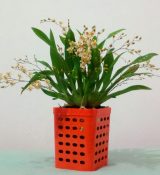Orchids Care & Culture Overview
Author: admin6 Comments

Orchid Plant and Flower Care and Culture Overview Information
The following tips are general. Specific requirements will depend on your orchid genus. Choose orchid plants for your geographical area and study what they need and want in order to create an environment they can flourish in.
Light
Light is one of the key factors to successfully growing and blooming orchids. Leaves are burned if the plants receive too much light. Not having enough light or light at the wrong time will most likely keep the plants from flowering. Follow these tips to make sure your orchid plants are getting the correct amounts of light that they need to grow and to produce those flourishing blooms.
- To make sure your plants grow evenly, regularly turn them. If your plants are in bud, don’t turn them. The flowers may twist all different directions to face the sun.
- Plants that are not receiving enough light, gradually move them into stronger light. Only increase light intensity by 100 to 200 foot candles at a time if you are using a light meter.
- If your plants are in bloom, move them away from full sun. Very bright sunlight can make the blooms fade and discolor.
- Know your plants. Some orchid plants will not flower without uninterrupted darkness at night.
Temperature
No matter where you grow your orchid plants and flowers, temperatures can vary considerably. As stated before, many different orchids require different environments, depending on several factors and their specific tastes in order to bring out the plants full blooming potential.
- Orchids that have lower temperature needs, place them near the floor, and on shelves above them, you can place the orchids that require higher temperatures. Those plants that are at the highest will most likely receive the highest temperatures.
- Use curtains to mimic climates of warmer during day hours and cooler during night hours.
- Don’t ever let your plants touch the windows in cold weather or hot weather. It will damage your leaves.
- Use fans to circulate warm and cool air and to circulate air around your plants. Don’t let cold or hot drafts blow on your plants.
Humidity
Orchid plants like to have the moisture in the air around them maintained. Create evaporation trays so your orchids can set on top of them.
- The pebbles or rocks that you use should be washed every 2-4 months in a weak bleach solution to remove any salts and algae that might have collected. Do not add the bleach to the water in your trays when they are in use.
- Use a suction tube to remove any excess water out of the trays after you have watered your plants.
- Mist your plants. They love it. It mimics the steamy air in there natural habitat. Only mist your plants if they have time to dry off before nightfall.
- Make sure your plants are evenly spaced apart so their air circulation is not restricted.
Watering
Good or bad watering habits can make or break your orchid plant. Be sure to study your specifc orchid’s needs when it comes to watering and feeding.
- Water your plants in the morning, so excess water will not evaporate right away.
- Orchid plants in small pots or clay pots are going to need to be watered more often than those plants that are in plastic pots or larger pots.
- Pseudo bulbs can be a real indicator whether a plant needs water or not. If the pseudo bulbs are shriveled you plant needs water. If they are nice and plump, then most likely your plant is receiving the right amount of water.
- Plants just recently repotted need to be watered more often than those that have been in their potting medium for a while. The air space in older potting medium shrinks, thus making it retain more water. At watering time, separate the plants in aged potting mediums from those that have been recently repotted.
Fertilizing
Fertilizing your orchid plants must be done with care. Study the specifc needs of your orchid plant before trying deifferent fertilizers.
- Over-fertilizing your orchid plants can cause the tips of the leaves to become dry and blackened. If this happens, cut off the burned tips with sterilized scissors and flush water through the potting medium to rid it of the fertilizer. If the symptoms are severe, you may need to repot the plant regardless the time of year.
- Only when your plant is in “active” growth should you fertilize your plant.
- Never guess at your fertilizer amount, always use a measuring device to use the proper amount.
- If your plants have damaged roots or is suffering from lack of water, don’t fertilize them. Water them with regular water until they have recovered.
- Fertilizers contain salts that can damage your plants. Water your plants immediately before you fertilize them. This prevents damage. Don’t try to force fertilizer to your plants. Over-fertilization actually stunts their growth.
Specific Orchids Care and Culture Information
Caring for, and culturing orchid plants is a fascinating pursuit, whether you are interested on a commercial level or simply as a hobby. There are, of course, thousands of different orchid plants, many of which have specific needs particular th their species. Below we have listed many of the most popular orchid plant species and specific growing techniques suitable for each type.
- Cattleyas
- Cymbidiums
- Dendrobium Phalaenopsis
- Nobile Dendrobiums
- Equitant Oncidiums
- Masdevallias
- Miltoniopsis (Miltonias)
- Oncidiums
- Paphiopedilums
- Phalaenopsis
- Phragmipediums
- Vandas
Header Image: Len Radin via PhotoPin.com
6 Responses to “Orchids Care & Culture Overview”
Leave a Reply


Ask an Expert
Questions about orchids?
Our experts love a challenge!
Photo of the Week
Submit your photo to be featured on the blog!
More Photo of the Week Winners
Submit Photo








My orchid lost all their blooms. Can you tell me what I did wrong and how do I get my orchid to bloom again.
After the flowers fall off, should I cut back the stalk or not? The flowers fell off about a month ago. Recently, I’ve noticed that end of the stalk is turning brown.
I have the same problem, my blooms fell off and and the leaves developed these holes in them should I cut off the stem or leave it?
I just recieved a beautiful orchid plant as a gift and the plant seemed to be quite healthy, but now the buds that weren’t so close to blooming are turning yellow and falling off! I am keeping it in my bathroom near a South facing window and I watered the plant when I got it home. It seemed very dry. I have only had the plant a few days. Is there any way to save the remaining green buds? What am I doing wrong? Should I just let the yellow buds fall off? What kind of fertilizer should I use? Thanks, Allison Drzal
@ Allison Drzal, This is very common in orchids, so no worries you can still save the other buds if you follow the specific growing guidelines for your orchid species. What you are referring to is commonly known as Bud Blast. You can cut off the yellow buds, they won’t bloom. Here’s more on the Common Plant Disease Bud Blast and how to spot and treat it.
As for the specific growing guidelines you’d have to tell me the species of orchid you have in your home.
Have fun growing!
My leaves are drooping. When I got the plant they were stiff or firm and they were straight. What do I do?